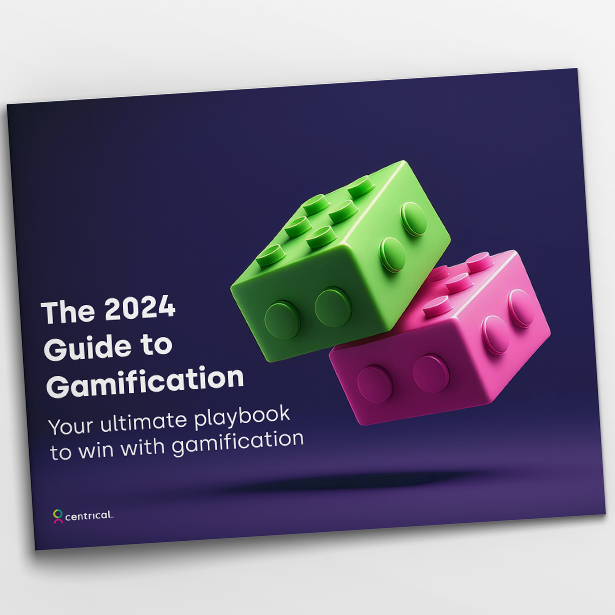Today’s enterprise faces many business challenges, especially in these times of uncertainty. Chief among these challenges is low employee engagement, which culminates in slumping performance and revenue, and soaring attrition rates. In recent years. organizations seeking solutions to these challenges have increasingly turned to gamification for employee engagement.
But what is gamification, and will it work for employee engagement? And will an employee gamification platform benefit your enterprise?
In short, yes. A resounding yes.
Gamification has been utilized for decades (even before the digital era) to change and reward behaviors that, engage employees and boost performance – with solid results. In today’s entry to the Centrical Blog, we’ll cover what gamification is, its impact on employee engagement, best practices when implementing an employee gamification platform, and how Centrical can help.
Gamification for employee engagement explained
“Gamification” might be a new term to some. But fear not—we’re not suggesting that employees spend time on their Nintendo Switch or mobile games during the workday! The concept of gamification for employee engagement is this: it is simply the application of game mechanics (e.g., scoring, leaderboards, competition, rewards, recognition, etc.) to non-game contexts, such as work or study. Through these elements, gamification builds employee engagement by tapping into intrinsic and extrinsic motivation while increasing the retention of both explicit and tacit knowledge.
By making gamification part of the daily flow of work, enterprises can encourage and reinforce behaviors that keep their employees engaged while building morale and camaraderie, boosting performance, and decreasing attrition.
Examples of employee engagement gamification
We’ve just covered the basics of gamification for engagement. You might be wondering about real-life examples of employee gamification. Below are a few examples:
Leaderboards
One of the basic tenets of gamification, leaderboards tap into the aspect of (friendly) competition. By providing a scored and visual assessment of where colleagues stand in relation to one another in achieving a goal, employees are much more motivated to achieve these goals and pass their coworkers on the leaderboard.
Progress Bars
Providing interactive visuals and enabling employees to track their own progress helps them see where they are and determine what they need to do to reach their goals. When employees can clearly see that they are making true progress towards a goal, they are much more engaged and productive (and may work to meet their goals sooner!).
Onboarding, Training, and Learning
Gamified and interactive onboarding and training are more engaging than traditional methods and consist of point-based learning modules and quizzes (often incorporating visual elements such as infographics and images, as well as auditory aspects to accompany the text.) Gamified learning helps employees determine their progress and areas of improvement and offers inclusivity across learning types.
Community Interaction
Employees should have a forum to interact positively with one another, and having a social element that allows likes, shout-outs, and other positive notes should be part of an employee gamification platform. (This is especially important for remote/hybrid employees to feel better connected to and engaged with the company and their team.)
Swag and Status Symbols
To follow up on the social aspect, one important must-do element of gamification for employee engagement is badging and achievements. This provides a highly visible proof of an employee’s efforts and achievements, leveling up, and in short, bragging rights that can keep that employee engaged and motivate others.
Recognition
One of the major goals of gamification for employee engagement is to change behavior and positively reinforce that behavior for desired outcomes. Offering recognition to employees is a surefire way to do just that. When an employee achieves a goal or another accomplishment, giving a reward or even a shout-out will help ensure those behaviors are repeated, and that employees stay engaged and on track.
How does gamification impact employee engagement?
Implementing an employee gamification platform provides a fun and intuitive approach to work and meeting goals, and gamification has been proven to have a tremendously positive impact on engagement, potentially boosting employee engagement by 48%.
Increased Motivation: Human motivations fall into two categories: intrinsic and extrinsic. Intrinsic motivation is internal and applies to, for instance, beating one’s own score and building progress and knowledge. Extrinsic motivation might take the form of beating team members’ scores, seeking badges, recognition, and real-life prizes. By competing against team members, as well as their own personal best, gamification boosts employee engagement and performance by tapping into these motivators.
More Interest in Continual Learning: Gamifying the learning and development process has proven highly effective; according to one Centrical client, 31% of their sales partners logged in for learning at least once a week, and the company saw a 50x higher learning module completion rate. (And consider this: 80% of U.S. workers believe that game-based learning is more engaging and 83% of those surveyed reported that gamified training increases motivation at work.)
Making Remote Employees Feel Less Remote: Remote and hybrid work models are here to stay, and it is imperative that employees feel engaged with your company and their colleagues. Gamification is an excellent tool for fostering connections between remote employees and their managers and teams, as well as keeping employees updated on company news, various aspects of their roles, and more.
Also consider the following statistics, courtesy of the survey we cited above:
- 72% of employees surveyed reported that they are motivated to work harder with gamification
- When it comes to energy levels, 71% of employees believe that gamification increased their energy
- Enterprises can increase company productivity by up to 50% and employee engagement by 60% with gamification
- 88% of survey respondents credited gamification with making them happier at work
- Finally, gamification isn’t just for the younger folks – 97% of workers 45 years of age and older report that gamification would improve work for them
Benefits of gamification for employee engagement
When employees are engaged, that means they are motivated, knowledgeable, and probably enjoying their work. When implementing an employee gamification platform to increase employee engagement, the enterprise will see a host of benefits, including (but certainly not limited to):
- Improved customer support and retention
- Increased employee performance
- Higher sales
- Better teamwork
- Higher enterprise revenue
- Reduced turnover and absenteeism
- Improved corporate culture
Best practices when implementing employee engagement gamification
As you’ve just read, gamification has a tremendous impact on employee engagement, and engaged employees deliver incredible benefits to the enterprise. To reap these benefits, you must take the right approach – below are a few getting-started considerations when implementing an employee gamification platform:
- Remember the goal. Gamification for engagement is intended to change behavior, which means that you will want to tap into both intrinsic and extrinsic motivation and should factor heavily into the design of the employee gamification platform.
- Gamification should be meaningful. Getting points or badges for basic tasks might seem fun at first, but the novelty (and employee engagement) will soon wear off. Rewards and achievements should be tied to a bona fide effort, and reflect the effort and skill applied.
- Go beyond the basics. Leaderboards, points, and badges are the most commonly used game mechanics, but your design cannot stop there. Incorporate elements that cover both intrinsic and extrinsic motivation. Some employee gamification ideas include stories and narratives, progress bars, challenges and missions, status symbols, social interaction, and more.
- Communicate, communicate, communicate. For a successful gamification program, ensure that you fully communicate to employees that the platform is in place, that they are familiar with the features and mechanics, know how to use the platform, and know to visit daily for learning, performance overviews, leaderboard activity, etc.
Centrical solutions for driving employee engagement via gamification
Since 2013, Centrical has partnered with enterprises across industries to change the game when it comes to employee engagement and retention. Below is a brief overview of what we deliver:
Holistic, Meaningful Gamification
The Centrical platform promotes personal progress and connectedness between employees and their teams by creating a sense of accomplishment and friendly competition, helping to engage, motivate, and retain employees.
Better Learning Through Microlearning
“Bite-sized” training modules delivered as part of the flow of work enable employees to build their knowledge and skills in just a few minutes a day and retain that knowledge better than they would with traditional learning methods.
Real-time Performance Insights
Centrical helps empower and engage employees by providing clarity on goals and instant feedback on progress. This feedback prompts microlearning modules based on performance gaps and growth opportunities.
Personalized, AI-Powered Coaching
The days of digging through spreadsheets to prepare for coaching sessions are over. Daily AI-powered performance insights and guided actions enable meaningful conversations and a continuous feedback loop.
Key Takeaways
There you have it – a brief overview of gamification, how gamification affects employee engagement and a few best practices. Below are a few items to keep in mind:
- Gamification isn’t a mere buzzword or passing trend. Applying gamification to boost engagement has been a practice for the past several decades, with proven results.
- There are ample areas for enterprises to apply a gamified approach as part of the employee workflow, including onboarding, learning and development, and coaching.
- Enterprises as a whole benefit from highly engaged employees. Engaged employees are higher performers, more productive, and tend to stay with their companies longer than those who are not engaged.
- To fully benefit from an employee gamification platform, take a meaningful approach that delivers elements that go beyond leaderboards and badges.
Are YOU ready to change the employee engagement game at your enterprise? Get started today by watching Centrical in action or scheduling a brief demo and personal consultation.
Engage and motivate your frontline teams
Improve performance with an AI-powered digital coach
Deliver world class CX with dynamic, actionable quality evaluations
Boost performance with personalized, actionable goals
Nurture employee success with the power of AI
Listen and respond to your frontline, continuously
Drive productivity with performance-driven learning that sticks
Drive agent efficiency, deliver client results
Keep tech teams motivated and proficient on products and services while exceeding targets
Maintain compliance while building customer happiness and loyalty
Enlighten energy teams to boost engagement
Engage, develop, and retain your agents while driving better CX
Improve the employee experience for your reservations and service desk agents








 Dalit Sadeh
Dalit Sadeh April Crichlow
April Crichlow Ella Davidson
Ella Davidson Linat Mart
Linat Mart Gal Rimon
Gal Rimon Jayme Smithers
Jayme Smithers Doron Neumann
Doron Neumann Daphne Saragosti
Daphne Saragosti Ronen Botzer
Ronen Botzer Ariel Herman
Ariel Herman